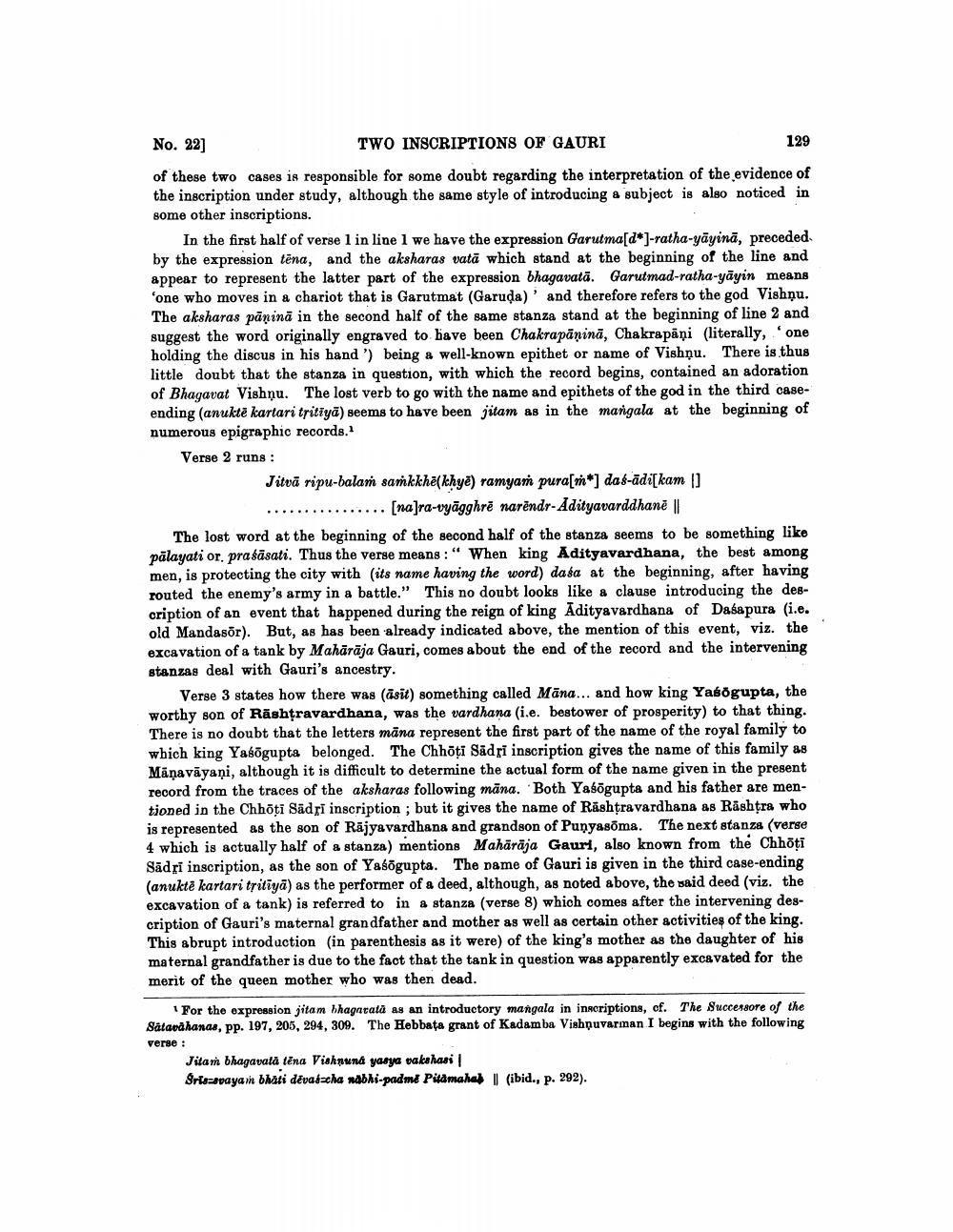________________
No. 22]
TWO INSCRIPTIONS OF GAURI
129
of these two cases is responsible for some doubt regarding the interpretation of the evidence of the inscription under study, although the same style of introducing a subject is also noticed in some other inscriptions.
In the first half of verse 1 in line 1 we have the expression Garutma[d*]-ratha-yāyinā, preceded. by the expression tena, and the aksharas vata which stand at the beginning of the line and appear to represent the latter part of the expression bhagavatā. Garutmad-ratha-yāyin means 'one who moves in a chariot that is Garutmat (Garuda) and therefore refers to the god Vishnu. The aksharas pāņina in the second half of the same stanza stand at the beginning of line 2 and suggest the word originally engraved to have been Chakrapāņina, Chakrapāņi (literally, one holding the discus in his hand ') being a well-known epithet or name of Vishnu. There is thus little doubt that the stanza in question, with which the record begins, contained an adoration of Bhagavat Vishnu. The lost verb to go with the name and epithets of the god in the third caseending (anukte kartari tritiya) seems to have been jitam as in the mangala at the beginning of numerous epigraphic records.1
Verse 2 runs :
Jitva ripu-balam samkkhe(khye) ramyam pura[m*] das-ādi[kam [] [na]ra-vyäggkrenarindr Adityavardhaně |
The lost word at the beginning of the second half of the stanza seems to be something like palayati or, prasāsati. Thus the verse means: "When king Adityavardhana, the best among men, is protecting the city with (its name having the word) dasa at the beginning, after having routed the enemy's army in a battle." This no doubt looks like a clause introducing the description of an event that happened during the reign of king Adityavardhana of Dasapura (i.e. old Mandasōr). But, as has been already indicated above, the mention of this event, viz. the excavation of a tank by Mahārāja Gauri, comes about the end of the record and the intervening stanzas deal with Gauri's ancestry.
Verse 3 states how there was (asit) something called Mana... and how king Yasögupta, the worthy son of Rashṭravardhana, was the vardhana (i.e. bestower of prosperity) to that thing. There is no doubt that the letters māna represent the first part of the name of the royal family to which king Yasögupta belonged. The Chhoti Sadri inscription gives the name of this family as Māṇavāyani, although it is difficult to determine the actual form of the name given in the present record from the traces of the aksharas following mana. Both Yasögupta and his father are mentioned in the Chhoți Sadri inscription; but it gives the name of Rashtravardhana as Rashtra who is represented as the son of Rajyavardhana and grandson of Punyasoma. The next stanza (verse 4 which is actually half of a stanza) mentions Mahārāja Gauri, also known from the Chhōṭī Sadri inscription, as the son of Yasögupta. The name of Gauri is given in the third case-ending (anukte kartari tritiya) as the performer of a deed, although, as noted above, the said deed (viz. the excavation of a tank) is referred to in a stanza (verse 8) which comes after the intervening description of Gauri's maternal grandfather and mother as well as certain other activities of the king. This abrupt introduction (in parenthesis as it were) of the king's mother as the daughter of his maternal grandfather is due to the fact that the tank in question was apparently excavated for the merit of the queen mother who was then dead.
For the expression jitam bhagavata as an introductory mangala in inscriptions, of. The Successore of the Satavahanas, pp. 197, 205, 294, 309. The Hebbata grant of Kadamba Vishnuvarman I begins with the following
verse :
Jitam bhagavata tena Vishnuna yasya vakshasi |
Sris-svayam bhāti devas-cha nabhi-padmē Pitämahab || (ibid., p. 292).




